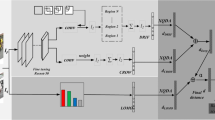Abstract
Pedestrian retrieval is an important technique of searching for a specific pedestrian from a large gallery. In this paper, we introduce three types of distance metrics for pedestrian retrieval, including learning-free distance metric methods, metric learning methods, and convolution neural network (CNN) methods, and evaluate the performance of different distance metrics using the Market-1501 database. The experiment shows that the CNN methods achieve the best results.
Access this chapter
Tax calculation will be finalised at checkout
Purchases are for personal use only
Similar content being viewed by others
References
Zheng F, Shao L. Learning cross-view binary identities for fast person re-identification. In: International joint conference on artificial intelligence. New York: USA; 2016. p. 2399–406.
Chen J, Wang Y, Qin J, Liu L, Shao L. Fast person re-identification via cross-camera semantic binary transformation. In: IEEE conference on computer vision and pattern recognition. Honolulu, HI, USA; 2017. p. 5330–9.
Zhang Z, Wang C, Xiao B, Zhou W, Liu S, Shi C. Cross-view action recognition via A continuous virtual path. In: IEEE conference on computer vision and pattern recognition. Portland, OR, USA; 2013. p. 2690–7.
Zhang Z, Wang C, Xiao B, Zhou W, Liu S. Action recognition using context-constrained linear coding. IEEE Signal Proc Let. 2012;19(7):439–42.
Zhang Z, Wang C, Xiao B, Zhou W, Liu S. Attribute regularization based human action recognition. IEEE T Inf Foren Sec. 2013;8(10):1600–9.
Farenzena M, Bazzani L, Perina A, Murino V, Cristani M. Person re-identification by symmetry-driven accumulation of local features. In: IEEE conference on computer vision and pattern recognition. San Francisco, CA, USA; 2010. p. 2360–7.
Zhang D, Lu G. Evaluation of similarity measurement for image retrieval. In: International conference on neural networks and signal processing. Nanjing, China; 2003. p. 928–31.
Cheng D, Cristani M, Stoppa M, Bazzani L, Murino V. Custom pictorial structures for re-identification. In: British machine vision conference. Dundee, UK; 2011. p. 6.
Zheng L, Shen L, Tian L, Wang S, Wang J, Tian Q. Scalable person re-identification: a benchmark. In: IEEE international conference on computer vision. Santiago, Chile; 2015. p. 1116–24.
Xing E, Jordan M, Russell S, Ng A. Distance metric learning with application to clustering with side-information. In: Advances in neural information processing systems. Vancouver, British Columbia, Canada; 2003. p. 521–8.
Weinberger K, Blitzer J, Saul K. Distance metric Learning for large margin nearest neighbor classification. In: Advances in neural information processing systems. Vancouver, British Columbia, Canada; 2006. p. 1473–80.
Davis J, Kulis B, Jain P, Sra S, Dhillon I. Information-theoretic metric learning. In: International conference on machine learning. Cincinnati, Ohio, USA; 2007. p. 209–16.
Guillaumin M, Verbeek J, Schmid C. Is that you? Metric learning approaches for face identification. In: IEEE international conference on computer vision. Berthold K.P. Horn; 2009. p. 498–505.
Koestinger M, Hirzer M, Wohlhart P, Roth P, Bischof H. Large scale metric learning from equivalence constraints. In: IEEE conference on computer vision and pattern recognition. Providence, RI, USA; 2012. p. 2288–95.
Liao S, Hu Y, Zhu X, Li S. Person re-identification by local maximal occurrence representation and metric learning. In: IEEE Conference on computer vision and pattern recognition. Boston, Massachusetts; 2015. p. 2197–206.
Zheng Z, Zheng L, Yang Y. A Discriminatively learned CNN embedding for person re-identification. ACM T Multim Comput. 2017;14(1):13.
Hermans A, Beyer L, Leibe B. In defense of the triplet loss for person re-identificationn. 2017. arXiv:1703.07737.
He K, Zhang X, Ren S, Sun J. Deep residual learning for image recognition. In: IEEE conference on computer vision and pattern recognition. Las Vegas, Nevada; 2016. p. 770–8.
Zhang Z, Huang M. Learning local embedding deep features for person re-identification in camera networks. Eurasip J Wirel Comm. 2018;1–9.
Acknowledgments
This work was supported by the National Natural Science Foundation of China under Grant No. 61711530240 and No. 61501327, Natural Science Foundation of Tianjin under Grant No. 17JCZDJC30600 and No. 15JCQNJC01700, the Fund of Tianjin Normal University under Grant No.135202RC1703, the Open Projects Program of National Laboratory of Pattern Recognition under Grant No. 201700001 and No. 201800002, the China Scholarship Council No. 201708120039 and No. 201708120040, the NSFC-Royal Society grant, and the Tianjin Higher Education Creative Team Funds Program.
Author information
Authors and Affiliations
Corresponding author
Editor information
Editors and Affiliations
Rights and permissions
Copyright information
© 2020 Springer Nature Singapore Pte Ltd.
About this paper
Cite this paper
Zhang, Z., Huang, M., Liu, S., Durrani, T.S. (2020). Evaluation Distance Metrics for Pedestrian Retrieval. In: Liang, Q., Liu, X., Na, Z., Wang, W., Mu, J., Zhang, B. (eds) Communications, Signal Processing, and Systems. CSPS 2018. Lecture Notes in Electrical Engineering, vol 516. Springer, Singapore. https://doi.org/10.1007/978-981-13-6504-1_140
Download citation
DOI: https://doi.org/10.1007/978-981-13-6504-1_140
Published:
Publisher Name: Springer, Singapore
Print ISBN: 978-981-13-6503-4
Online ISBN: 978-981-13-6504-1
eBook Packages: EngineeringEngineering (R0)




